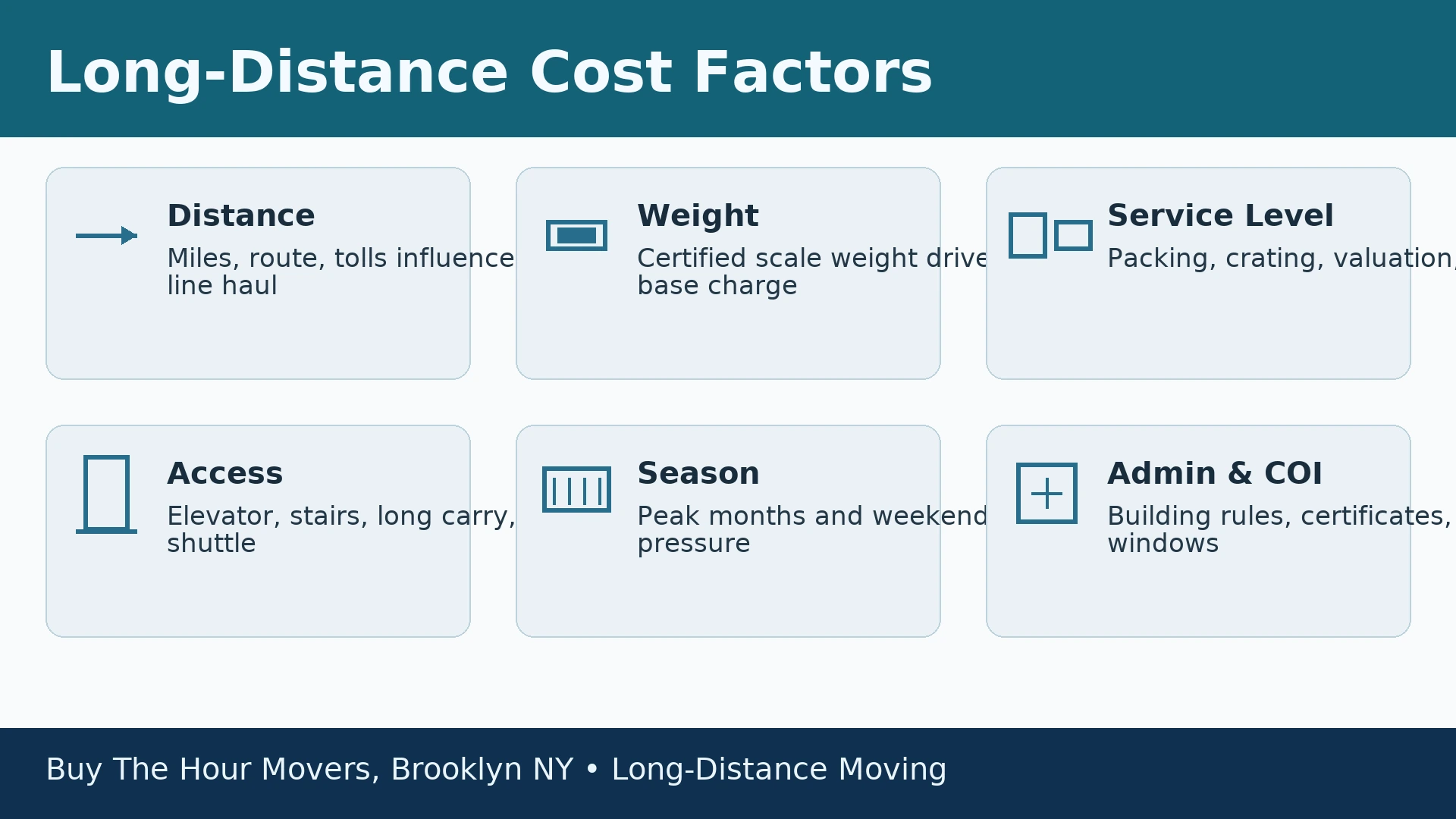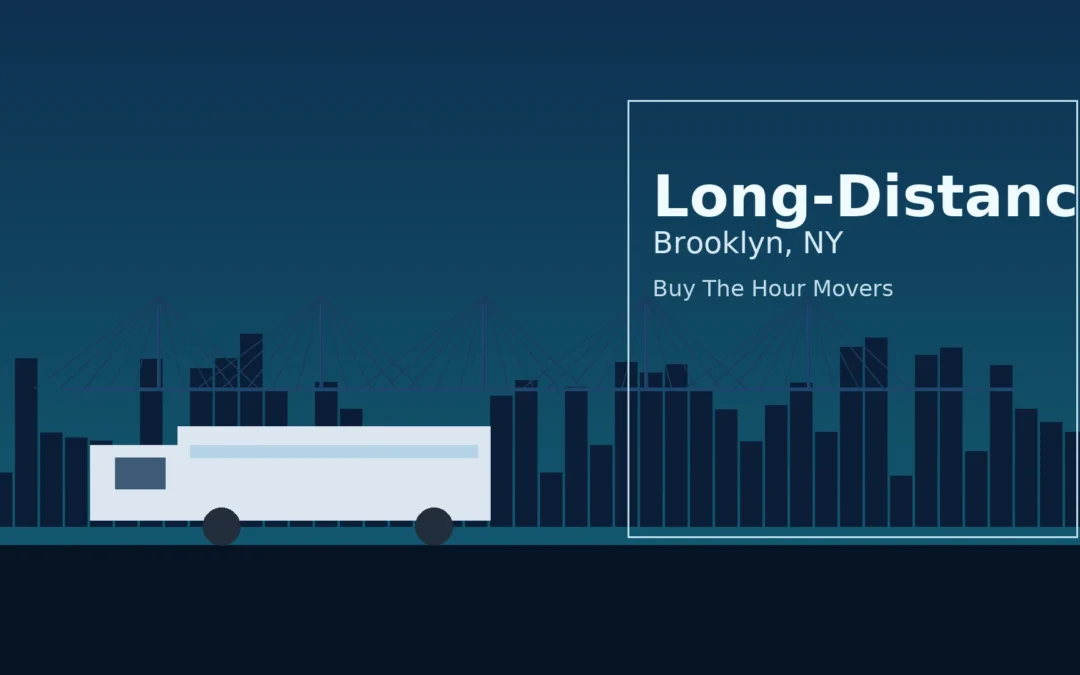If you want a clear, local answer for Brooklyn, start with a visual survey and a written estimate from Buy The Hour Movers. For fast help from our long-distance movers in Brooklyn, request a quote and we will price your shipment accurately and transparently.
Quick answer
Long-distance moving costs are driven by your shipment’s weight, distance, and service level. Interstate moves are regulated, so you are entitled to a written estimate and consumer protections that define how final charges and delivery work. Review the FMCSA’s official guidance before you sign anything: Rights and Responsibilities When You Move, Estimating Charges, and the Ready to Move brochure.
How are long-distance moving costs calculated?
Movers price interstate shipments using a standardized structure so you can compare apples to apples.
- Line-haul charges: Based on actual weight and miles between origin and destination.
- Accessorial services: Packing, crating, appliance service, stair or long-carry, shuttle for tight streets, storage-in-transit.
- Origin and destination conditions: Walk-up floors, elevator reservations, certificates of insurance, building loading dock windows.
- Season and date: Peak months and weekends tend to book first, which affects availability and rates.
- Valuation coverage: Basic released value is limited, full-value protection raises the price but protects your goods.
- NYC logistics: Truck routing, legal parking windows, and building rules in Brooklyn can add time that must be scheduled correctly. See NYC DOT’s guidance on truck routes and commercial vehicle parking
Tip: Your mover must give you a written estimate that lists transportation, accessorial, and any advance charges. A “rate quote” alone is not an estimate. Source: FMCSA Estimating Charges.
Do long-distance movers charge by weight or volume?
For interstate moves, reputable carriers price by weight recorded on certified scales, not by cubic feet. FMCSA rules require written estimates and explain the distinctions between binding and non-binding estimates, plus how volume-to-weight conversions must be disclosed if used. See FMCSA: Estimating Charges and Rights and Responsibilities When You Move.
Why weight-based pricing is safer for consumers
- Weighing empty and then loaded provides an objective number.
- Written inventories and scale tickets let you audit charges.
- Volume estimates can be misinterpreted by packing density and truck loading patterns.

What is the average cost of a 1,000‑mile move?
There is no single average that fits every shipment, because tariffs vary by carrier, season, weight, and services. Use this scenario method to frame expectations before you book:
- Start with weight: Studio often 2,000–3,000 lb, one‑bedroom 3,000–5,000 lb, two‑bedroom 5,000–8,000 lb. Heavier homes run higher.
- Check minimums: Many tariffs use a minimum weight for long-distance. If you fall below the minimum, pricing will still round up to that minimum.
- Add accessorials: Packing cartons, crating TVs, long-carry, stair flights, shuttle if a tractor‑trailer cannot access your block, storage-in-transit if timing between closings does not align.
- Include valuation: Full value protection increases price and is recommended for high‑value shipments.
- Account for NYC variables: Loading dock windows, elevator scheduling, and legal parking time can change crew hours. Route planning must avoid restricted parkways. See NYC’s truck route map.
The most reliable way to get a number is to request a binding or not‑to‑exceed estimate after a virtual or in‑home survey. See FMCSA’s guidance on binding estimates.
When should I book long-distance movers?
- Peak season (May to September): aim for 6–8 weeks in advance.
- Off‑peak: 3–4 weeks often works, earlier is better for complex buildings.
- Delivery windows: Consolidated shipments run on scheduled routes and windows, dedicated trucks can tighten dates at a premium.
- Documentation: Reserve building elevators and request your certificate of insurance details from management early so your move date is not delayed.
How can I reduce long-distance moving costs without risk?
- Declutter by weight: Sell, donate, or recycle heavy, low‑value items before the survey.
- Pack some items, not all: Let pros pack fragile and high‑value items, self‑pack linens and books if your timeline allows.
- Flexible dates: Mid‑week, mid‑month often improves availability.
- Prepare access: Secure parking and elevator windows to avoid long carries and extra crew time.
- Inventory accuracy: Share photos or a room‑by‑room list to prevent surprises at load time.
- Know your rights: Review FMCSA Protect Your Move and the official Ready to Move checklist.
Brooklyn specifics that affect price and timing
Truck routing and clearances
- Commercial vehicles cannot use most parkways. Crews must plan legal truck routes and low‑clearance constraints. See NYC DOT Truck Routing.
Loading and parking
- Expect strict time windows and enforcement. Review NYC DOT’s commercial vehicle parking basics and any posted “Loading Only” zones on your block.
Building requirements
- Many buildings require a certificate of insurance and elevator reservations. Ask management for their template at least a week ahead.
Which estimate type should I ask for?
- Binding: A fixed price for listed items and services. Good for price certainty when your inventory is final. See FMCSA’s guidance on binding estimates.
- Non‑binding: Final charges are based on actual weight and tariff. Under FMCSA rules, movers must deliver upon payment of 100% of a binding estimate or 110% of a non‑binding estimate at delivery, with any balance billed later. Source: FMCSA Rights and Responsibilities.
FAQ
How are long-distance moving costs calculated?
By actual shipment weight, miles, and selected services, plus access at each building. FMCSA requires written estimates that list all charges. See Estimating Charges.
Do long-distance movers charge by weight or volume?
Interstate moves are typically priced by certified scale weight. If a mover uses volume, they must disclose the conversion method to weight in writing. See FMCSA requirements summary.
What is the average cost of a 1,000‑mile move?
There is no one-size number. Use the scenario method above and request a binding or not‑to‑exceed estimate after a survey.
When should I book long-distance movers?
Six to eight weeks in peak months is prudent. Book earlier if your building requires long elevator windows or has strict COI rules.
How can I reduce costs without hidden risks?
Trim weight, pick flexible dates, and keep access easy. Confirm valuation and estimate type in writing. Review FMCSA’s Protect Your Move.
Get a guaranteed-plan quote and move date
Buy The Hour Movers is based in Brooklyn, NY. We service long-distance relocations from Brooklyn to the Northeast, Mid‑Atlantic, Southeast, Midwest, and beyond. Start with a quick survey, then choose a binding or not‑to‑exceed plan.
- Request your quote: Brooklyn Long‑Distance Movers
- Call or message: Contact Us
Serving nearby neighborhoods and boroughs
Williamsburg, Park Slope, Brooklyn Heights, Bushwick, and Fort Greene, plus moves connecting to Manhattan, Queens, the Bronx, and Staten Island.
Useful local links:
- Williamsburg: https://en.wikipedia.org/wiki/Williamsburg,_Brooklyn
- Park Slope: https://en.wikipedia.org/wiki/Park_Slope
- Brooklyn Heights: https://en.wikipedia.org/wiki/Brooklyn_Heights
- Bushwick: https://en.wikipedia.org/wiki/Bushwick,_Brooklyn
- Fort Greene: https://en.wikipedia.org/wiki/Fort_Greene,_Brooklyn
- Manhattan Borough: https://www.manhattanbp.nyc.gov/
- Queens Borough: https://www.ny.gov/counties/queens
- The Bronx Borough: https://bronxboropres.nyc.gov/
- Staten Island Borough: https://www.nyc.gov/site/dcas/business/dcasmanagedbuildings/staten-island-borough-hall.page
Sources cited in this guide
- FMCSA, Your Rights and Responsibilities When You Move (2023 update)
- FMCSA, Estimating Charges (Subpart D)
- FMCSA, Ready to Move brochure
- FMCSA, Protect Your Move
- NYC DOT, Truck Routing and Truck Route Map
- NYC DOT, Parking a Truck or Commercial Vehicle







